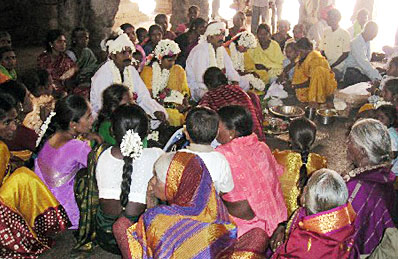The Indian village societies are combined of people following different religious paths and traditions. The formation of the Indian village society largely varies from one region to another. Though there is some similarity in the religious practices and cultural activities in most Indian village societies, their education system or the position of women differ from each other. There are certain other things that can be found in almost every village society in India. People in most of the villages share various common utilities like ponds, grazing grounds, temples and shrines, cremation grounds, schools, sitting spaces under large shade trees, wells, wastelands, etc.
The religious customs and practices in Indian village society vary in different parts of the country, depending upon their cultures and lifestyles. Most of the village societies in India have a Gram Devata (village deity) and consider this deity as the protector of the village. The villagers worship the deity regularly for the well being and prosperity of the village. The villagers usually inhabit a world full of divine and semi-divine beings like the tree spirits (Yakshas), ghosts (Bhootas), Puranic, local, personal and ancestral gods. All of these sprits and gods co-exist in an Indian village society.
Fairs and festivals have always been an integral part of Indian village society. The villagers celebrate different types of festivals like religious, regional, seasonal, or sports festivals together. The style of celebrating festivals also differs from one region to another. Among the religious festivals, the Hindu festivals like Holi, Diwali, Durga Puja, Navaratri, Rakhi Purnima, Baisakhi, Dola Yatra, Mahashivratri, etc. are celebrated in most villages in India. The other religious festivals include the Muslim festivals like Eid-ul-Fitr, Eid-ul-Adha, Muharrum; the Buddhist festivals like Buddha Purnima; the Christian festivals like Christmas and the festivals of other religions like Mahavir Jayanti, Gurupurbas, etc. The villagers share lots of light moments with each other during these festivals and perform different forms of folk music and dance. The festivals act as a great platform for social communication in the Indian village society.
 Besides religious festivals, there are a few other types of festivals celebrated by people in the Indian village society. These festivals include Poush Mela, Vasanta Utsav, the tribal festivals like Chapchar Kut, Mim Kut, Ningol Chakouba, Heikru Hitongba, etc. The people in an Indian village society also come together in other occasions like marriage ceremonies, or funerals, etc. Marriage ceremonies are considered as major celebrating occasions in Indian villages. The villagers enjoy the marriage party together. They also come together in grief during funerals and mourn for the dead.
Besides religious festivals, there are a few other types of festivals celebrated by people in the Indian village society. These festivals include Poush Mela, Vasanta Utsav, the tribal festivals like Chapchar Kut, Mim Kut, Ningol Chakouba, Heikru Hitongba, etc. The people in an Indian village society also come together in other occasions like marriage ceremonies, or funerals, etc. Marriage ceremonies are considered as major celebrating occasions in Indian villages. The villagers enjoy the marriage party together. They also come together in grief during funerals and mourn for the dead. The educational scenario in the Indian village society has evolved from the ancient times to the modern times. While, only the members of higher castes used to get education in the ancient period, the people from all castes have a chance to get educated in the contemporary period. The Government of India and the State Governments have established numerous schools and colleges in the Indian villages, in the recent years. As a result, the rural literacy rate in most parts of India has reached an impressive level. Apart from the men, the women in Indian village society are also getting much exposure to modern education, now-a-days.
The position of women in the Indian village society has also changed with time. The women were treated with great respect and honour in the ancient period in Indian villages. They were provided with the opportunity of getting proper education and they used to take active part in the decision making process of their families as well. The scenario changed during the medieval period when the women in Indian village society were restricted within the premises of their houses. There was almost no scope for the women to get education. However, the position of women has changed a lot in the contemporary period. They are now getting enough exposure to modern education and are also getting involved in different kinds of occupation.
An Indian village society represents the real essence of India, "unity in diversity". Most of the Indian villages are characterised by a multiplicity of economic, caste, kinship, occupational and religious groups. The rich diversity in cultural heritage of the village societies in different parts of India attracts people from all over the world. They visit the Indian village society to get the feel of real India and also to experience the cultural richness of India.
No comments:
Post a Comment